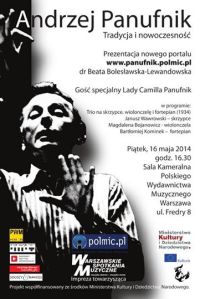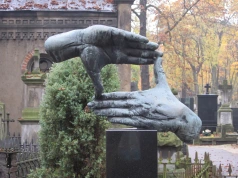• WL100/1-81: The Complete List
Friday, 2 January 2015 2 Comments
2015
January
• 2.01.15 WL100/1-81: The Complete List
• 1.01.15 WL100/81: Roussel 3, Lutosławski 3
2014
December
• 31.12.14 WL100/80: Lutosławski’s Chair
• 30.12.14 WL100/79: Jeux vénitiens conducting score
• 29.12.14 WL100/78: Jeux vénitiens pitch designs
• 28.12.14 WL100/77: Lutosławski’s French Bookmarks
• 27.12.14 WL100/76: Lutosławski Learns To Drive
• 26.12.14 WL100/75: Lutosławski’s Bookshelves
• 25.12.14 WL100/74: Lutosławski Rules!
• 24.12.14 WL100/73: Lutosławski’s Batons
• 23.12.14 WL100/72: Lutosławski’s Desk
2013
November
• 27.11.13 WL100/71: Lissa on Concerto for Orchestra
• 26.11.13 WL100/70: Concerto for Orchestra, **26.11.54
• 18.11.13 WL100/69: Livre, **18 November 1968
• 15.11.13 WL100/68: Nie oczekuję dziś nikogo
• 11.11.13 WL100/67: Notebook, 11 November 1961 on conducting
• 9.11.13 WL100/66: Overture, **9 November 1949
October
• 26.10.13 WL100/65: Mr and Mrs Lutosławscy in Prague
• 24.10.13 WL100/64: Notebook, 24 October 1959 Webern
• 22.10.13 WL100/63: Mi-parti, **22 October 1976
• 19.10.13 WL100/62: Notebook, 19 October 1960 Pierre Schaeffer and objet sonore
• 15.10.13 WL100/61: Symphonic Variations
• 14.10.13 WL100/60: Cello Concerto, **14 October 1970
• 6.10.13 WL100/59: Lutosławski in Moscow (1951)
September
• 16.09.13 WL100/58: ‘old’ Derwid CDs
• 15.09.13 WL100/57: ‘el Derwid’ CD
• 6.09.13 WL100/56: Los Angeles (1985) reposting of Lutosławski in Los Angeles (1985) (2.09.11)
• 5.09.13 WL100/55: Death of Lutosławski’s Father
• 3.09.13 WL100/54: Lutosławski and Panufnik (1945)
• 2.09.13 WL100/53: Trio, **2 September 1945
August
• 27.08.13 WL100/52: His Last BBC Prom
• 26.08.13 WL100/51: July Garland (1949) – the music
• 21.08.13 WL100/50: Volcano in Łowicz (1949) Gałczyński
• 20.08.13 WL100/49: 22 July 1949 and a letter July Garland
• 19.08.13 WL100/48: 22 July 1944 and after Lutosławski’s medals
• 18.08.13 WL100/47: Folk Melodies, **22 July 1946
• 17.08.13 WL100/46: Notebook June-July
June
• 25.06.13 WL100/45: Trois poèmes, UK*25 June 1969
• 20.06.13 WL100/44: Paroles tissées, **20 June 1965
• 17.06.13 WL100/43: Variations, **17 June 1939
• 12.06.13 WL100/42: 33 ‘Derwid’ songs published
May
• 23.05.13 WL100/41: Symphony 4 (Polish premiere)
• 22.05.13 WL100/40: London Sinfonietta, 22 May 1993
• 18.05.13 WL100/39: Polar Music Prize, 18 May 1993
• 9.05.13 WL100/38: Les dessins de Michaux
• 9.05.13 WL100/37: Trois poèmes, **9 May 1963
• 8.05.13 WL100/36: Le songe de Desnos (1938)
• 4.05.13 WL100/35: Lutosławski in Riga
April
• 24.04.13 WL100/34: Jeux vénitiens, **24 April 1961
• 13.04.13 WL100/33: Zanussi documentary (complete)
• 12.04.13 WL100/32: Les espaces, **12 April 1978
• 9.04.13 WL100/31: Notebook, 9 April 1969 on conducting (and Boulez)
• 7.04.13 WL100/30: Notebook, 7 April 1960 on Cage
• 6.04.13 WL100/29: Notebook, 6 April 1961 on ‘poor caricatures’
• 3.04.13 WL100/28: Jazz Conversations (Lutosphere)
March
• 19.03.13 WL100/27: Notebook, 19 March 1961 on rain and Jeux vénitiens
• 13.03.13 WL100/26: Notebook, 13 March 1961 (2) on electronic music
• 13.03.13 WL100/25: Notebook, 13 March 1961 (1) on feeling in music
• 11.03.13 WL100/24: Notebook, 11 March 1961 on new instruments (and Jeux vénitiens)
• 9.03.13 WL100/23: 9-10 March 1957 speech to Polish Composers’ Union
• 9.03.13 WL100/22: Chain 1, figs 40-41
February
• 16.02.13 WL100/21: Funeral and Homily, 16.02.94
• 15.02.13 WL100/20: Dance Preludes, **15 February 1955
• 12.02.13 WL100/19: ‘Lutosławski live’, 12-19.02.93
• 12.02.13 WL100/18: Notebook, 12 February 1961 on his current music
• 6.02.13 WL100/17: Notebook, 6 February 1959 as a parachutist
• 2.02.13 WL100/16: Philharmonia Festival, 2-12.02.89
January
• 26.01.13 WL100/15: Thank-you note, 26 January 1993
• 22.01.13 WL100/14: Lutosławski at Polish Radio new archival website
• 19.01.13 WL100/13: In Conversation with Zanussi
• 17.01.13 WL100/12: ‘Breaking Chains’, BBC 1997
• 16.01.13 WL100/11: ‘The Hidden Composer’ Witold Lutosławski and Polish Radio
• 13.01.13 WL100/10: ‘Breaking Chains’, GSMD 1997
• 12.01.13 WL100/9: Lutosławski’s Carpet
• 10.01.13 WL100/8: Musique funèbre, 10 January 1958
• 5.01.13 WL100/7: Lutosławski info online
• 3.01.13 WL100/6: Epitaph, **3 January 1980
• 2.01.13 WL100/5: Notebook, 2 January 1963 on Cymer the carpenter
2012
December
• 31.12.12 WL100/4: Lutosławski Likenesses
• 20.12.12 WL100/3: Lutosławski in Belfast (gallery)
• 18.12.12 WL100/2: Lutosławski in Belfast (DMus)
• 17.12.12 WL100/1: Lutosławski in Belfast
• 17.12.12 WL100



 2007
2007






